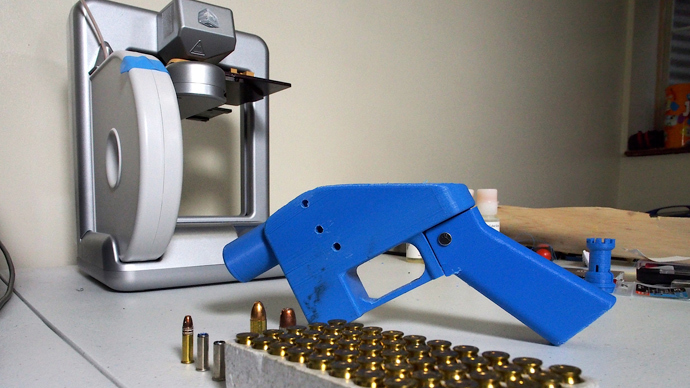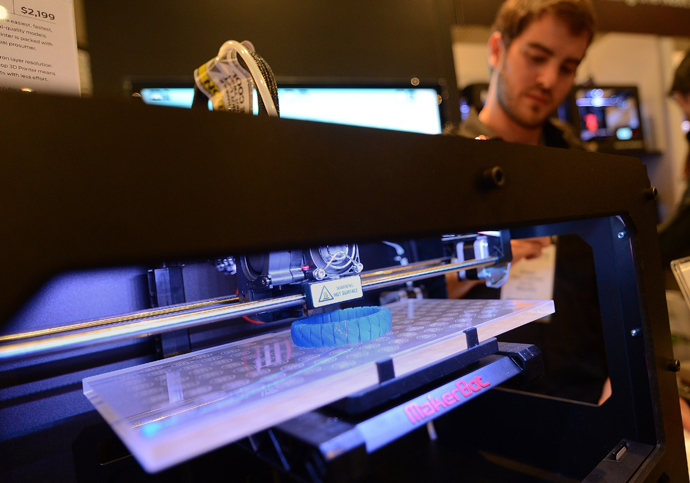Consumer safety is key issue in 3D printing, but no point banning it

It’s a big mistake to resist 3D printing technology as it opens up many opportunities, Hod Lipson, Associate professor from the Cornell University, told RT.
RT:Philadelphia's become the first US city to ban the unlicensed printing of 3D weapons - so does that mean they pose a serious threat to society?
Hod Lipson: Absolutely not. I think it’s a universal technology that can be used in lots of different ways, some good, some not so good. But there are so many opportunities opened up by this technology, so I would say it’s not a threat in any way. But it is alarming that people have started producing printed guns with it, and I think it definitely calls some attention to this technology in a sort of surprising new way.
RT:You could buy a weapon for only a tiny fraction for the cost of the 3D metal printer that just created a working gun. But the technology could get cheaper. Should lawmakers elsewhere act now so not everyone can start making their own DIY weapons?
HL: I think it would be impossible to enforce any such kind of law. It’s a little bit like trying to regulate education of chemistry because some may learn how to produce explosives, or to try to regulate something else like software programming because someone could produce a virus. It’s really impossible to regulate and I think it’s not necessary because the advantages are so much larger than the disadvantages, so I think it will be a big mistake to try to restrict this technology in any way.

RT:The pioneers of this know-how are approaching this from a purely engineering point of view. But what will the fallout be from their technology if it’s put to commercial production?
HL: Nobody knows really. I think there are many laws on the book that are difficult to enforce but just out there, I think, it’s a clear message: “You are not supposed to do that. If your kid asks to download a blueprint of a gun and print it under thousand-dollar plastic at home, it’s a clear message that’s not a good thing. You are not supposed to do it.” But of course people will still do it and that’s when the enforcement comes in. But I think it’s more about message than actual practicality.
RT:In the US there is a huge amount of gun owners and gun crime. How would things change if people start printing metal guns?
HL: I can’t really think of nightmares, but it’s really a very powerful technology that is used in a lot of different ways. This is like education: everybody can learn how to read, then people can start reading the wrong things, etc. But that never happened. I’m fairly optimistic that this technology will lead to new jobs, new businesses, new kinds of products that cannot be made today. I think we’ll see more and more of that.
3D-printed guns are more of an indication of one aspect that hasn't been resolved yet and that’s consumer safety. I think as this technology progresses people will start making not just jewelry and various parts that are ornamental, but actually make parts that have safety issues with them. If you download a blueprint for a bicycle helmet, for example, and then print it at home, how do you know that it’s safe to use? The plastic gun is not safe to use for the person using it and I think it’s an example of things to come where people will start making shoddy parts, so we need some way to regulate it, to have some quality insurance, some standardization around 3d printing, so to take care of that.
You can see what already has happened in other places, where, for example, insurance companies stepped in and said: “If you want this to be insured you have to get a certified blueprint. If you want to have some guarantees from the vendors, it has to be designed, vetted and tried.” So there is a lot of mechanisms that can allow it to happen, that don’t necessarily come from the regulators but come from business practices, as happened in many other areas before.
RT:Could these printers be used to make anything more dangerous than a gun?
HL: This is probably my imagination, but I would say the most dangerous thing is a gun that doesn't look like a gun, but looks like a flower vase or something. And this ability to make things in any shape and form really defies a lot of the conventional thinking around regulating guns, around detecting them. It’s a whole new world when it comes to controlling these kinds of things.
The statements, views and opinions expressed in this column are solely those of the author and do not necessarily represent those of RT.
The statements, views and opinions expressed in this column are solely those of the author and do not necessarily represent those of RT.












